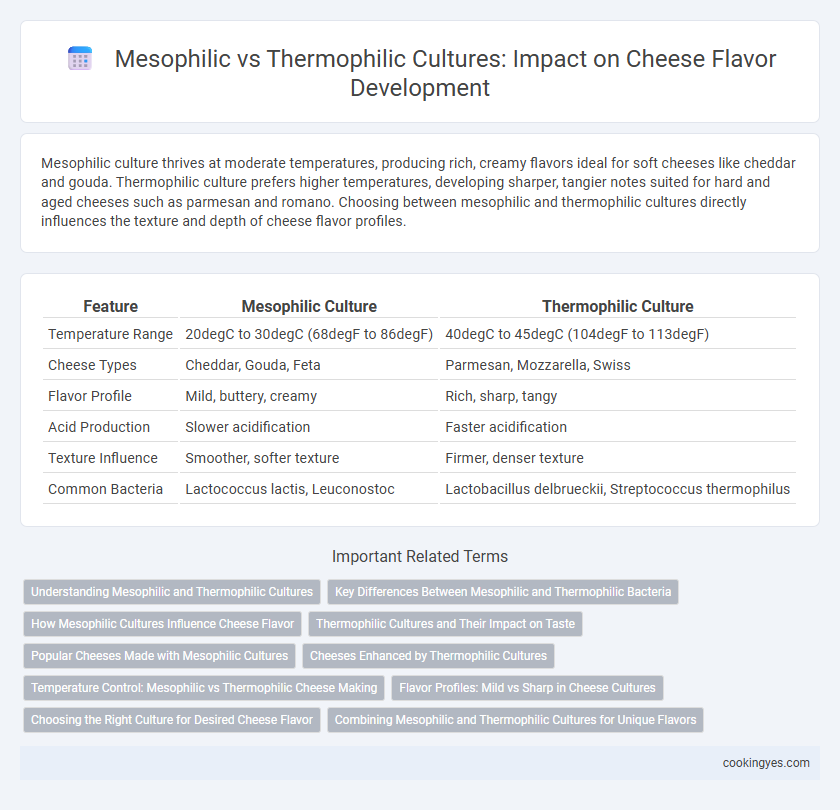Mesophilic culture thrives at moderate temperatures, producing rich, creamy flavors ideal for soft cheeses like cheddar and gouda. Thermophilic culture prefers higher temperatures, developing sharper, tangier notes suited for hard and aged cheeses such as parmesan and romano. Choosing between mesophilic and thermophilic cultures directly influences the texture and depth of cheese flavor profiles.
Table of Comparison
| Feature | Mesophilic Culture | Thermophilic Culture |
|---|---|---|
| Temperature Range | 20degC to 30degC (68degF to 86degF) | 40degC to 45degC (104degF to 113degF) |
| Cheese Types | Cheddar, Gouda, Feta | Parmesan, Mozzarella, Swiss |
| Flavor Profile | Mild, buttery, creamy | Rich, sharp, tangy |
| Acid Production | Slower acidification | Faster acidification |
| Texture Influence | Smoother, softer texture | Firmer, denser texture |
| Common Bacteria | Lactococcus lactis, Leuconostoc | Lactobacillus delbrueckii, Streptococcus thermophilus |
Understanding Mesophilic and Thermophilic Cultures
Mesophilic cultures thrive at moderate temperatures between 20degC and 30degC, producing mellow, creamy, and buttery flavors ideal for cheeses like cheddar and gouda. Thermophilic cultures prefer higher temperatures ranging from 40degC to 50degC, generating tangier, more complex flavors suited for cheeses such as parmesan and mozzarella. Understanding the temperature range and flavor profiles of mesophilic and thermophilic cultures is essential for cheesemakers aiming to control texture and taste during fermentation.
Key Differences Between Mesophilic and Thermophilic Bacteria
Mesophilic bacteria thrive at moderate temperatures between 20degC and 30degC, producing creamy, mild cheese flavors commonly found in cheeses like cheddar and gouda. Thermophilic bacteria prefer higher temperatures from 40degC to 50degC, generating sharper, tangier flavors typical in cheeses such as parmesan and romano. The key differences lie in their optimal temperature ranges and the resulting impact on acid production and texture development during cheese fermentation.
How Mesophilic Cultures Influence Cheese Flavor
Mesophilic cultures thrive at moderate temperatures between 20-30degC and play a crucial role in developing rich, tangy, and creamy flavors in cheeses like Brie, Camembert, and Cheddar. These cultures produce lactic acid, peptides, and flavor compounds that enhance the complex, mellow profile characteristic of many soft and semi-hard cheeses. By fermenting lactose slowly, mesophilic bacteria contribute to a balanced acidity and texture, resulting in cheese with smooth mouthfeel and subtle aromatic notes.
Thermophilic Cultures and Their Impact on Taste
Thermophilic cultures thrive at higher temperatures, typically between 104degF and 122degF (40degC to 50degC), accelerating acid production and resulting in a firmer texture in cheeses such as Parmesan, Romano, and Swiss. These cultures promote the development of complex, nutty, and tangy flavor profiles by encouraging specific bacterial strains that generate aromatic compounds during fermentation. Their influence enhances the maturation process, leading to robust, sharp, and distinct tastes characteristic of aged cheeses crafted with thermophilic starters.
Popular Cheeses Made with Mesophilic Cultures
Mesophilic cultures, thriving at moderate temperatures between 20-30degC, are essential in producing popular cheeses like Brie, Camembert, and Cheddar, imparting rich, creamy, and tangy flavors. These cultures promote slower acidification, enhancing the development of complex dairy notes and improved texture in cheeses such as Havarti and Gouda. Unlike thermophilic cultures used in harder cheeses, mesophilic bacteria allow for a balanced, nuanced flavor profile favored in many traditional soft and semi-hard cheese varieties.
Cheeses Enhanced by Thermophilic Cultures
Thermophilic cultures thrive at higher temperatures between 104degF and 131degF, producing cheeses like Parmesan, Romano, and Swiss known for their sharp, nutty, and complex flavors. These cultures enhance flavor profiles by promoting extensive acidification and proteolysis, resulting in a firm texture and rich taste. The use of thermophilic cultures is essential in creating aged cheeses with intensified depth and character compared to those produced with mesophilic cultures.
Temperature Control: Mesophilic vs Thermophilic Cheese Making
Mesophilic cultures thrive at temperatures between 68degF and 104degF (20degC to 40degC), ideal for producing creamy, mild cheeses like cheddar and gouda by promoting slow acidification. Thermophilic cultures require higher temperatures, typically 109degF to 131degF (43degC to 55degC), which accelerate acid production for firmer textures and sharper flavors found in cheeses like parmesan and mozzarella. Precise temperature control ensures optimal bacterial activity in each culture type, directly influencing cheese taste, texture, and aging potential.
Flavor Profiles: Mild vs Sharp in Cheese Cultures
Mesophilic cultures produce cheese with mild, creamy, and buttery flavor profiles, ideal for cheeses like cheddar and colby that ripen at cooler temperatures around 70-86degF (21-30degC). Thermophilic cultures generate sharper, tangier, and more complex flavors derived from higher temperature aging, typically between 104-122degF (40-50degC), suitable for cheeses such as mozzarella and parmesan. The choice of culture directly influences the flavor intensity and texture, with mesophilic favoring subtle, smooth tastes while thermophilic cultivates bold, piquant notes.
Choosing the Right Culture for Desired Cheese Flavor
Mesophilic cultures thrive between 68degF and 98degF and develop rich, creamy, and tangy flavors ideal for cheeses like cheddar and gouda, while thermophilic cultures prefer higher temperatures of 110degF to 130degF, producing sharp, nutty, and complex tastes suited for mozzarella and Parmesan. Selecting the right starter culture significantly influences the acidification rate and texture, directly impacting the cheese's final flavor profile and maturation process. Understanding the specific flavor attributes tied to mesophilic and thermophilic cultures allows cheesemakers to tailor recipes for desired taste and consistency.
Combining Mesophilic and Thermophilic Cultures for Unique Flavors
Combining mesophilic and thermophilic cultures in cheese production enhances flavor complexity by leveraging the slow acidification of mesophilic bacteria with the rapid acidification of thermophilic strains. This synergy promotes diverse enzymatic activity, creating balanced tanginess and rich, nuanced aromas in cheeses like hybrid washed-rind or semi-hard varieties. The integration of both cultures also optimizes texture development and improves overall cheese maturation profiles.
Mesophilic Culture vs Thermophilic Culture for Cheese Flavor Infographic

 cookingyes.com
cookingyes.com